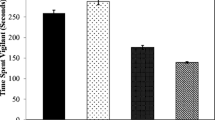Abstract
We determined how the presence of heterospecific individuals in the vicinity of a focal individual affects the behavior of two critically endangered species of cranes on their wintering grounds at Cheolwon in the Korean Demilitarized Zone. The red-crowned crane, Grus japonensis, is larger than the white-naped crane, Grus vipio, and it dominates the white-naped crane in aggressive interactions. We showed that the dominant species increases foraging activity in the presence of the subordinate species presumably because of scrounging of food from the subordinate. Because interspecific interactions may affect avian endangerments these behavioral findings should be taken into account when managing winter refuges for the two endangered crane species.



Similar content being viewed by others
References
Barnard CJ (1984) The evolution of food-scrounging strategies within and between species. In: Producers and scroungers. Strategies of exploitation and parasitism. Croom Helm, London, pp 95–127
Barnard CJ, Thompson DB (1985) Gulls and plovers: the ecology of mixed species feeding groups. Groom Helm, London
Beauchamp G (2001) Should vigilance always decrease with groups size? Behav Ecol Sociobiol 51:47–52
BirdLife International (2001) Threatened birds of Asia: the BirdLife International red data book. BirdLife International, Cambridge
Cha YI (1986) Vegetation on the wintering ground of the white-naped crane, Grus vipio Pallas, on the Han River Estuary. In: Report on the wintering ground of the white-naped crane, Grus vipio Pallas, on the Han River Estuary (In Korean with an English abstract). Korean Association for the Conservation of Nature, Kyonggi-do Province, South Korea, pp 79–88
Elgar MA (1989) Predator vigilance and group size in mammals and birds: a critical review of the empirical evidence. Biol Rev Camb Philos Soc 64:13–33
Fujita G, Hong-Liang G, Ueta M, Goroshko O, Krever V, Ozaki K, Mita N, Higuchi H (2004) Comparing areas of suitable habitats along traveled and possible shortest routes in migration of white-naped cranes Grus vipio in East Asia. Ibis 146:461–474
Giraldeau LA, Beauchamp G (1999) Food exploitation: searching for the optimal joining policy. Trends Ecol Evol 14:102–106
Higuchi H, Ozaki K, Fujita G, Minton J, Ueta M, Soma M, Mita N (1996) Satellite tracking of white-naped crane migration and the importance of the Korean Demilitarized Zone. Conserv Biol 10:806–812
Higuchi H, Shibaev Y, Minton J, Ozaki K, Surmach S, Fujita G, Momose K, Momose Y, Ueta M, Andronov V, Mita N, Kanai Y (1998) Satellite tracking of the migration of the red-crowned crane Grus japonensis. Ecol Res 13:273–282
Higuchi H, Pierre J, Krever V, Andronov V, Fujita G, Kiyoaki O, Goroshko O, Ueata M, Smirensky S, Mita N (2004) Using remote technology in conservation: satellite tracking white-naped cranes in Russia and Asia. Conserv Biol 18:136–147
Koo TH (1986) Present status and wintering ecology of the white-naped crane, Grus vipio Pallas, in the Han River estuary. In: Report on the wintering ground of the white-naped crane, Grus vipio Pallas, on the Han River Estuary (In Korean with an English abstract). The Korean Association for the Conservation of Nature, Kyonggi-do Province, South Korea, pp 67–77
Lee SD (2004) The conservation strategy of DMZ wetland in Cheolwon, Korea. J Korean Wetl Soc 6:95–105
Meine CD, Archibald GW (1996) The cranes: status survey and conservation action plan. IUCN, Gland, Switzerland. Northern Prairie Wildlife Research Center Online. http://www.npwrc.usgs.gov/resource/birds/cranes/index.htm (Version 02MAR98)
Pae SH, Won P (1994) Wintering ecology of red-crowned cranes and white-naped cranes Grus japonensis and G. vipio in the Cheolwon Basin, Korea. In: Higuchi H, Minton J (eds) The future of cranes and wetlands: Proceedings of the International Symposium. Wild Bird Society of Japan, Tokyo, pp 97–196
Pulliam HR (1973) On the advantages of flocking. J Theor Biol 38:419–422
Reed JM (1999) The role of behavior in recent avian extinctions and endangerments. Conserv Biol 13:232–242
Roberts G (1996) Why individual vigilance declines as group size increases. Anim Behav 51:1077–1086
StatSfor Inc. (1999) STATISTICA for Windows. StatSoft, Tulsa, Okla. http://www.statsoft.com
Sutherland WJ, Pullin AS, Dolman PS, Knight TM (2004) The need for evidence-based conservation. Trends Ecol Evol 19:305–308
Won PO (1981) Illustrated flora and fauna of Korea, vol 25. Avifauna. Ministry of Education, Korea
Won PO (1986) The present status and conservation of cranes wintering (or staging) in Korea, with special reference to the status of the white-naped crane, Grus vipio Pallas, migrating to the Han River Estuary. In: Report on the wintering ground of the white-naped crane, Grus vipio Pallas, on the Han River Estuary (in Korean with English translation). The Korean Association for the Conservation of Nature, Kyonggi-do Province, South Korea, pp 37–60
Yoo SH (2004) Some factors affecting the distribution of Grus japonensis and Grus vipio behavioral aspects of family groups (in Korean with an English abstract). PhD thesis, Kyung Hee University, Seoul
Zar JH (1999) Biostatistical analysis. Prentice Hall, Saddle River, NJ
Acknowledgements
This study was funded by the following organizations: the Crowder Messersmith Conservation Fund (2005), the KOSEF International Program (2005–2006; research fellowship), and the JSPS (fellowship 2006) and KRF-2005-003-C00162.
Author information
Authors and Affiliations
Corresponding author
Appendix
Appendix
About this article
Cite this article
Lee, S.D., Jabłoński, P.G. & Higuchi, H. Effect of heterospecifics on foraging of endangered red-crowned and white-naped cranes in the Korean Demilitarized Zone. Ecol Res 22, 635–640 (2007). https://doi.org/10.1007/s11284-006-0067-z
Received:
Accepted:
Published:
Issue Date:
DOI: https://doi.org/10.1007/s11284-006-0067-z




